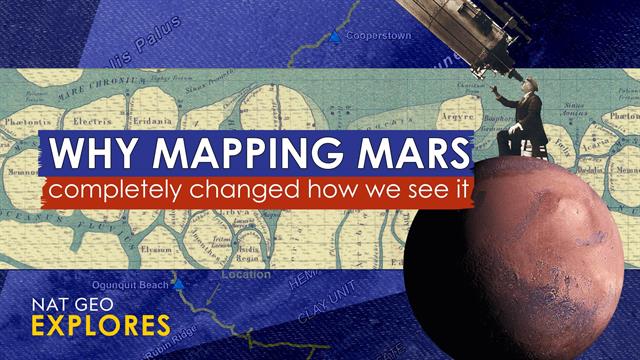How Cartographic Conflicts Shaped Mars Exploration

How Cartographic Conflicts Shaped Mars Exploration. Discover more detailed and exciting information on our website. Click the link below to start your adventure: Visit Best Website. Don't miss out!
Table of Contents
How Cartographic Conflicts Shaped Mars Exploration: A History of Martian Mapmaking Disputes
The red planet has captivated humanity for centuries, fueling dreams of exploration and inspiring countless works of science fiction. But the path to understanding Mars hasn't been a smooth, linear journey. Instead, the history of Martian exploration is interwoven with surprising cartographic conflicts – disagreements over the planet's features, their names, and even their very existence – that have significantly impacted the direction and focus of scientific missions. These mapping controversies reveal fascinating insights into the evolution of planetary science and the human element behind seemingly objective scientific endeavors.
<h3>Early Martian Cartography: A Foundation of Discord</h3>
Early telescopic observations of Mars, beginning in the 17th century, laid the groundwork for future cartographic clashes. The limited resolution of early telescopes resulted in wildly differing interpretations of Martian surface features. Observers reported canals, seas, and continents, often fueled by preconceived notions about life beyond Earth. These early maps, while inaccurate, became the foundation for subsequent research, leading to ongoing debates about the nature of the Martian landscape. The famous "canals" observed by Giovanni Schiaparelli, though later proven to be optical illusions, profoundly influenced early 20th-century Mars exploration and ignited the public imagination.
<h3>The Naming Conventions Conundrum: A Battle for Nomenclature</h3>
The naming of Martian features has been a source of contention throughout history. The International Astronomical Union (IAU) acts as the ultimate arbiter, but the process isn't always straightforward. Early names were often bestowed based on cultural biases and national priorities, sometimes leading to conflicts and debates about appropriate terminology. For example, the naming of craters after famous scientists often favored those from certain nations or disciplines, sparking discussions about inclusivity and equitable representation in planetary nomenclature. This ongoing debate underscores the importance of considering diverse perspectives in the naming of celestial bodies.
<h3>Modern Cartographic Challenges: High-Resolution Data and Interpretation</h3>
The advent of high-resolution imagery from robotic missions like the Mars Reconnaissance Orbiter (MRO) and the Curiosity rover has brought a new layer of complexity to Martian cartography. While the technology provides incredibly detailed maps, interpreting this data presents unique challenges. Differing geological interpretations of the same features – canyons, craters, and ancient riverbeds – lead to ongoing scientific debates. These debates are healthy for scientific progress, but they highlight the subjective element in scientific interpretation even with objective data.
- Disagreements over subsurface water: The presence and location of potential subsurface water ice and liquid water remain a highly contested area.
- Debates on the evidence of past life: Interpretation of geological formations, especially those that may indicate past life, are often heavily debated within the scientific community.
- Competing theories on Martian geological processes: Different models exist for explaining the evolution of the Martian surface and atmosphere, leading to ongoing discussions among planetary scientists.
<h3>The Future of Martian Cartography: Collaboration and Consensus</h3>
The challenges of Martian cartography are far from over. As we move towards crewed missions to Mars and increasingly sophisticated robotic exploration, the need for accurate and consistent maps will only intensify. The future of Martian cartography will require:
- Enhanced international collaboration: Shared data and open access initiatives are crucial for fostering consensus and minimizing conflicts.
- Improved data analysis techniques: Advancements in artificial intelligence and machine learning can help automate map creation and minimize human biases.
- Standardized naming conventions: Rigorous adherence to IAU guidelines and inclusive naming practices are essential for creating equitable and transparent cartographic systems.
Navigating the complexities of Martian cartography is essential for successful exploration. By understanding and addressing the historical and ongoing conflicts, we can ensure future missions benefit from accurate and consistent maps, ultimately enhancing our understanding of the red planet and our place in the universe. Stay informed on the latest developments in Mars exploration by subscribing to our newsletter!

Thank you for visiting our website wich cover about How Cartographic Conflicts Shaped Mars Exploration. We hope the information provided has been useful to you. Feel free to contact us if you have any questions or need further assistance. See you next time and dont miss to bookmark.
Featured Posts
-
 Subida De Pensiones En Enero Preguntas Frecuentes Y Respuestas
Jan 24, 2025
Subida De Pensiones En Enero Preguntas Frecuentes Y Respuestas
Jan 24, 2025 -
 Como Assistir Bangu X Flamengo Transmissao Ao Vivo E Online
Jan 24, 2025
Como Assistir Bangu X Flamengo Transmissao Ao Vivo E Online
Jan 24, 2025 -
 Multas Dgt La Ubicacion De Los 24 Nuevos Radares Instalados
Jan 24, 2025
Multas Dgt La Ubicacion De Los 24 Nuevos Radares Instalados
Jan 24, 2025 -
 Sao Paulo Esclarece Nao Ha Proposta Para Cedric Soares
Jan 24, 2025
Sao Paulo Esclarece Nao Ha Proposta Para Cedric Soares
Jan 24, 2025 -
 Enquete Attaque Allemagne Les Suspects Et Les Mobiles
Jan 24, 2025
Enquete Attaque Allemagne Les Suspects Et Les Mobiles
Jan 24, 2025
Latest Posts
-
 Deckee App Yanchep News On Dfes And Marine Rescue Wa Collaboration
Feb 05, 2025
Deckee App Yanchep News On Dfes And Marine Rescue Wa Collaboration
Feb 05, 2025 -
 Adrianne Baums Impact On Contemporary Art A Critical Analysis
Feb 05, 2025
Adrianne Baums Impact On Contemporary Art A Critical Analysis
Feb 05, 2025 -
 Is Puto Offensive A Sensitivity Guide To Its Usage
Feb 05, 2025
Is Puto Offensive A Sensitivity Guide To Its Usage
Feb 05, 2025 -
 C Battery Recycling A Guide To Responsible Disposal
Feb 05, 2025
C Battery Recycling A Guide To Responsible Disposal
Feb 05, 2025 -
 Sam Newman Fresh Allegations Surface Regarding Blair Interview
Feb 05, 2025
Sam Newman Fresh Allegations Surface Regarding Blair Interview
Feb 05, 2025
